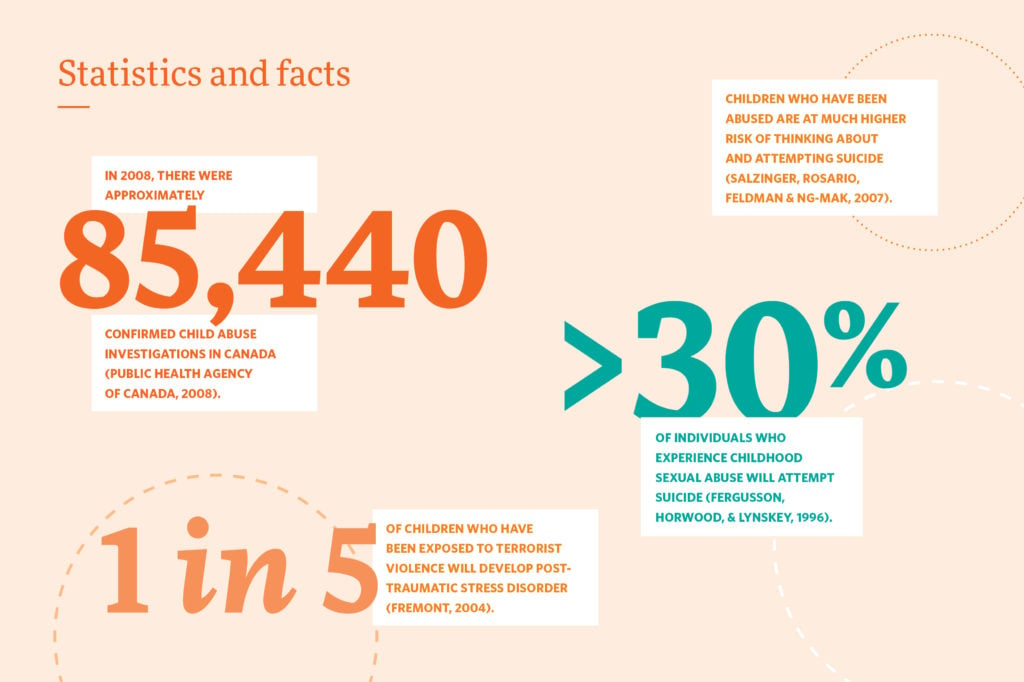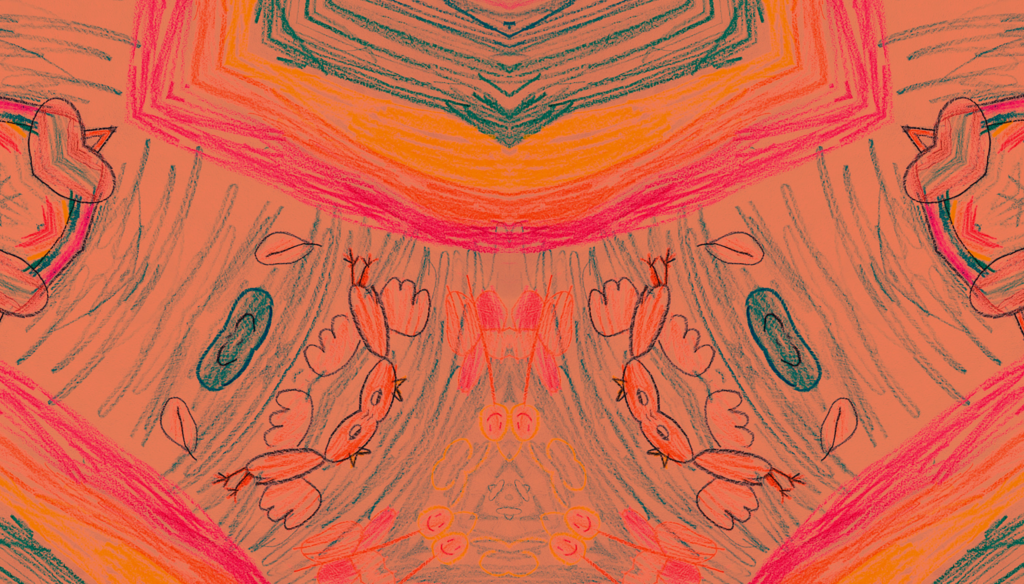This toolkit is one of a suite of three focused on trauma. The full suite includes: Trauma and suicide, Trauma and suicide in children and Trauma and suicide in Indigenous people.
Introduction
When children and adolescents experience trauma, their personal development can be affected. They may develop mental health issues and have a higher risk for suicide (Felitti, et al., 1998; Gaskill & Perry, 2012; Hodas, 2006; Levers, 2012; Shaw, 2000).
Unresolved trauma in childhood and adolescence is linked to an increased risk of suicide ideation and if unaddressed, can escalate with age — potentially leading to suicide attempts or death by suicide. Early intervention post-trauma is crucial (Dube et al., 2001; Herba, Ferdinand, van der Ende & Verhulst, 2007; Pfeffer, Normandin & Kakuma, 1998).

What is Trauma?
Trauma is “a horrific event beyond the scope of normal human experience” (Greenwald, 2007).
Some examples of traumatic experiences for children and adolescents include:
- neglect;
- violence in their community, home, or school;
- sexual or physical abuse;
- motor vehicle collisions;
- medical trauma (eg. surgery);
- refugee and war zone trauma;
- terrorism; and
- natural disasters.
(American Psychological Association (APA), 2008; Spinazzola, et al., 2014; The National Child Traumatic Stress Network (NCTSN), n.d.a)
Some immediate and future effects of trauma are:
- poor academic performance;
- insomnia;
- relationship problems;
- depression;
- alcoholism or illicit drug use; and/or
- suicide attempts.
(Centre for Addictions and Mental Health, 2012; Centers for Disease Control and Prevention, n.d.)
Coping with Trauma
Children can better cope with trauma if they:
- have positive relationships with family and friends;
- have built up resiliency;
- have access to health care and social services; and
- live in communities that support parents and undertake initiatives to prevent abuse.
(Centers for Disease Control and Prevention, 2015; Hodas, 2006)
Warning signs and Symptoms of Trauma
Children and adolescents who have been traumatized may:
- Develop new fears and anxiety, e.g. fear future trauma;
- Feel helpless, numb, alone, and/or depressed;
- Exhibit changes in behaviour, e.g. decrease in appetite;
- Experience sleep difficulties, e.g. recurrent nightmares, insomnia;
- Have feelings of guilt and shame surrounding the traumatic event;
- Complain of physical ailments, e.g. upset stomach;
- Continually tell others about the event;
- Fear separation from parents/caregivers (young children);
- Exhibit dysregulated behaviour, e.g. crying, irritability, aggression (young children);
- Exhibit regression, e.g. bedwetting, baby talk (young children);
- Ask about death (young children);
- Re-enact traumatic event through play (children);
- Become more attached and reliant on caregivers (children);
- Experience suicidal ideation (teens);
- Engage in risky behaviours, e.g. drug/alcohol abuse and sexual promiscuity (teens); and/or
- Start self-harming behaviours, e.g. cutting, eating disorders (teens).
(APA, 2008; Hodas, 2006; Shaw, 2000; NCTSN, n.d.b)
What is Trauma-Informed Care?
Health care professionals are more aware of the effects of trauma than ever, and this has led to the creation of Trauma-Informed Care (TIC) — a determined effort to implement a better approach to treating patients that takes into account the impact that previous traumatic experiences have had on an individual’s overall mental health. TIC represents a significant paradigm shift from what has been called a “deficit perspective” to one that is strengths-based (British Columbia Ministry of Health, 2013). The new essential question reflects this shift, having changed from:
“What is wrong with you?” to “What has happened to you?” (Rosenberg, 2011)
Trauma-Informed Care (TIC) can be adopted by anyone working in the “behavioural health system” including:
- emergency rooms;
- doctors’ offices; and
- counselling offices.
Being trauma-informed means:
- understanding the prevalence of trauma and its impact;
- recognizing the signs and symptoms of traumatization;
- creating an emotionally and physically safe space, and empowering the individual with an active voice in collaborative decision-making; and
- respecting the person’s experience through active listening, being sensitive to the language used, being transparent, being trustworthy, and offering stability and consistency
(Bath, 2008; Hodas, 2006; Rosenberg, 2011; SAMHSA, 2015; Huckshorn & LeBel, 2013).
Read more about TIC in iE13: Trauma Informed Care: Trauma, Substance abuse and Suicide Prevention
Trauma-Informed Interventions and Therapies
Trauma-Focused Cognitive Behavioural Therapy (TF CBT)
An approach that uses a combination of Cognitive Behavioural Therapy (CBT) and trauma-informed practice for working with children who have experienced traumatic events and their parents (Levers, 2012).
Child-Parent Psychotherapy (CPP)
This treatment is used to restore and protect the child’s mental well-being by supporting and improving the child-caregiver relationship (Levers, 2012).
Parent-Child Interaction Therapy (PCIT)
PCIT is a two-phase approach, 1. Child-Directed Interaction (CDI) and 2. Parent-Directed Interaction (PDI), with a focus on positive behaviours and techniques for behavioural management (Levers, 2012).
Play Therapy
Play therapy gives children the opportunity to reenact their trauma allowing them to process the experience (Levers, 2012).
Eye Movement Desensitization and Reprocessing for Children and Adolescents (EMDR)
Clients process and describe the emotionally difficult memories associated with their traumatic experiences, while keeping their focus on an external stimulus
(The California Evidence-Based Clearinghouse for Child Welfare (CEBC), 2014; Levers, 2012).
Prolonged Exposure Therapy for Adolescents (PE-A)
PE-A has a main goal of helping clients achieve the ability to emotionally process their traumatic experiences through in vivo exposure, imaginal exposure, education about reactions to trauma and breathing techniques (CEBC, 2014; Levers, 2012).
Resources
Center on the Developing Child: Harvard University
The National Child Traumatic Stress Network (NCTSN)
Substance Abuse and Mental Health Services Administration (SAMHSA)
211 (Available in British Columbia, Alberta, Saskatchewan, Ontario, Quebec, New-Brunswick, Nova Scotia and Nunavut)
Kids’ Help Phone 1-800-668-6868
National Domestic Violence Hotline 1-800-799-7233 or 1-800-787-3224 (TDD)
References
American Psychological Association. (2008). Children and trauma: Update for mental health professionals. Washington, DC: American Psychological Association. Retrieved from http://www.apa.org/pi/families/resources/children-trauma-update.aspx
Bath, H. (2008). The three pillars of trauma-informed care. Reclaiming Children and Youth, 17(3), 17-21.
California Evidence-Based Clearinghouse for Child Welfare. (2014). List of programs. Retrieved from http://www.cebc4cw.org/search/by-program-name/
Centre for Addictions and Mental Health. (2012). Trauma: What is trauma? Retrieved from http://www.camh.ca/en/hospital/health_information/a_z_mental_health_and_addiction_information/Trama/Pages/default.aspx
Centers for Disease Control and Prevention. (2015). Child maltreatment: Risk and protective factors. Retrieved from http://www.cdc.gov/ViolencePrevention/childmaltreatment/riskprotectivefactors.html
Dube, S., Anda, R., Felitti, V., Chapman, D., Williamson, D., & Giles, W. (2001). Childhood abuse, household dysfunction, and the risk of attempted suicide throughout the life span: Findings from the adverse childhood experiences study. Journal of the American Medical Association, 286(24), 3089-3096.
Felitti, V. & Anda, R. (2003). Origins and essence of the study. ACE Reporter, 1(1). Retrieved from http://www.acestudy.org/yahoo_site_admin/assets/docs/ARV1N1.127150541.pdf
Fergusson, D., Horwood, J., & Lynskey, M. (1996). Childhood sexual abuse and psychiatric disorder in young adulthood, II: Psychiatric outcomes of childhood sexual abuse. Journal of the American Academy of Child & Adolescent Psychiatry, 35, 1365–1374.
Fremont, W.(2004). Childhood reactions to terrorism-induced trauma: A review of the past 10 years. Journal of the American Academy of Child & Adolescent Psychiatry 43(4), 381–392. doi:10.1097/00004583-200404000-00004
Gaskill, R. & Perry, B. (2012). Child sexual abuse, traumatic experiences and their effect on the developing brain. In P. Goodyear-Brown (Ed.), Handbook of child sexual abuse: Identification, assessment and treatment (pp. 29-49). New York, NY: John Wiley & Sons, Inc.
Greenwald, R. (2007). EMDR: Within a phase model of trauma-informed
treatment. New York: Routledge.
Herba, C., Ferdinand, R., van der Ende, J., & Verhulst, F. (2007). Long-term associations of childhood suicide ideation. Journal of the American Academy of Child and Adolescent Psychiatry, 46(11), 1473-1481.
Hodas, G. (2006). Responding to childhood trauma: The promise and practice of trauma informed care. Retrieved from http://www.childrescuebill.org/VictimsOfAbuse/RespondingHodas.pdf
Huckshorn, K. & LeBel, J. (2013). Trauma-informed care. In Yeager, K., Cutler, D., Svendsen, D., & Sills, G.(Eds.), Modern community approach mental health: An interdisciplinary approach (pp. 62-83). Oxford, UK: Oxford University Press.
Levers, L. (2012). Trauma counseling: Theories and interventions. Springer Publishing Company. NY: New York.
National Child Traumatic Stress Network. (n.d.a). Refugees and the refugee experience. Retrieved from http://nctsn.org/trauma-types/refugee-trauma/learn-about-refugee-experience
National Child Traumatic Stress Network. (n.d.b). Resources for parents and caregivers. Retrieved from http://www.nctsn.org/resources/audiences/parents-caregivers
Pfeffer, C., Normandin, L., & Kakuma, T. (1998). Suicidal children grow up: Relations between family psychopathology and adolescents’ lifetime suicidal behavior. Journal of Nervous and Mental Disease, 186(5), 269-275.
Public Health Agency of Canada. (2008). Canadian incidence study of reported child abuse and neglect: Major findings. Retrieved from http://cwrp.ca/sites/default/files/publications/en/CIS-2008-rprt-eng.pdf
Rosenberg, L. (2011). Addressing trauma in mental health and substance use treatment. The Journal of Behavioral Health Services & Research, 38(4), 428-431.
Salzinger, S., Rosario, M., Feldman, R., & Ng-Mak, D. (2007). Adolescent suicidal behavior: Associations with preadolescent physical abuse and selected risk and protective factors. Journal of the American Academy of Child & Adolescent Psychiatry, 46(7), 859-866.
Shaw, J. (2000). Children, adolescents and trauma. Psychiatric Quarterly, 71(3), 227- 243.
Spinazzola, J., Hodgdon, H., Liang, L., Ford, J., Layne, C., Pynoos, R., Briggs, E., Stolbach, B., & Kisiel, C. (2014). Unseen wounds: The contribution of psychological maltreatment to child and adolescent mental health and risk outcomes. Psychological Trauma: Theory, Research, Practice, and Policy, 6(1), s18-s28. DOI: 10.1037/a0037766
Substance Abuse and Mental Health Services Administration. (2015). Trauma-informed approach and trauma-specific interventions. Retrieved from http://www.samhsa.gov/nctic/trauma-interventions
